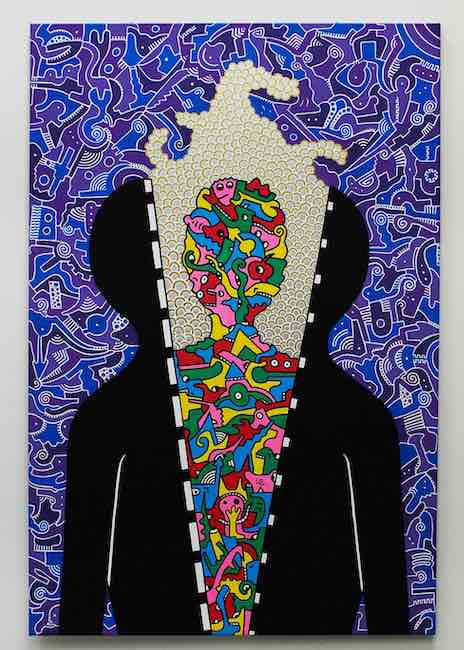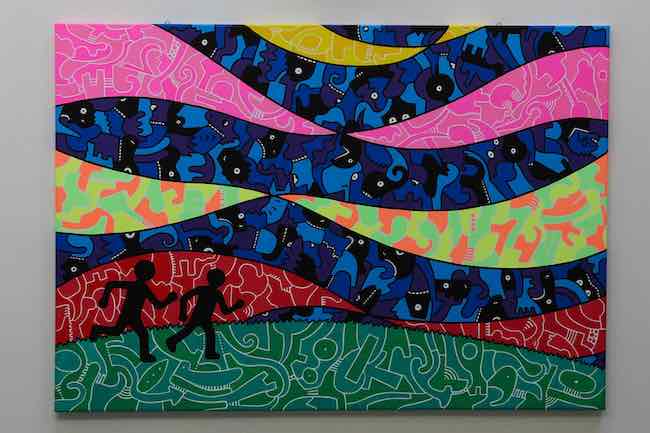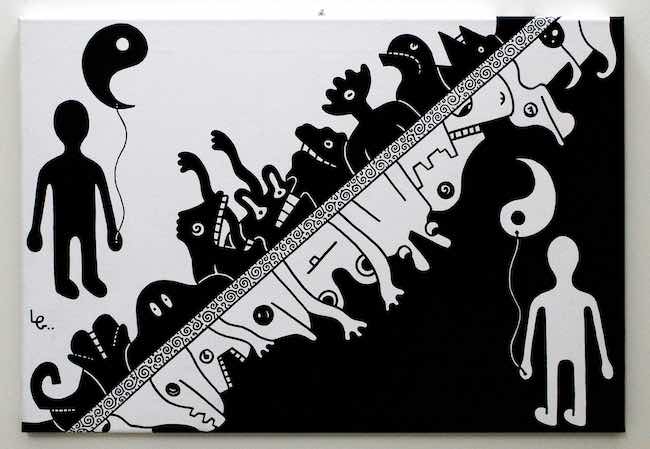Nel corso dell’arte moderna, in particolar modo intorno alla metà del Novecento, hanno cominciato a delinearsi alcuni movimenti per i quali la priorità era parlare a un pubblico ampio, scegliendo un linguaggio immediato, facilmente comprensibile, pur celando significati più profondi di quelli dell’immediatezza delle immagini attraverso cui venivano raccontati; l’imperativo era allontanarsi dai salotti elitari di difficile accesso alla maggior parte delle persone e di portare l’arte in luoghi popolari, immediatamente visibili quanto inaspettati, giungendo così a dialogare con il pubblico attraverso un nuovo modo di fare arte. Il protagonista di oggi prende spunto da quelle rivoluzioni stilistiche del secolo scorso per dar vita a uno stile personale, diretto e immediato ma in grado di coinvolgere l’osservatore che non può fare a meno di entrare con curiosità nel suo mondo colorato.
Intorno agli anni Cinquanta del Ventesimo secolo, quando l’economia statunitense stava rifiorendo dopo i sacrifici della seconda guerra mondiale e nel momento in cui stava nascendo una nuova classe sociale, la media borghesia, che generava nuove leggi di mercato grazie a un inaspettato potere d’acquisto, alcuni artisti capitanati da Andy Warhol avvertirono l’importanza di entrare in quel nuovo mondo che poteva diventare sensibile all’arte pur non avendo le basi culturali o le possibilità economiche di acquistare un’opera unica. Fu così che il genio della Pop Art elaborò e mise a punto l’idea delle copie numerate, ottenute con la tecnica della serigrafia, che costituivano una terra di mezzo più accessibile tra opera originale e semplice stampa, dando pertanto l’opportunità a un pubblico molto più ampio di poter avere in casa un pezzo d’arte. Non solo, anche il linguaggio espressivo doveva andare verso simboli e icone care al grande pubblico come i miti del cinema tanto quanto quelli dei generi di consumo facilmente reperibili in tutti i supermercati, o il mondo dei fumetti o ancora, come nel caso della Street Art che spesso si mescolò e si avvicinò alla Pop Art per intenzione di partenza, attraverso immagini semplificate che potessero essere realizzate velocemente sui muri delle città, sui sottopassaggi, sui ponti. Da Warhol a Lichtenstein, da Kaufman a Kostabi, l’arte cominciò a diventare un mezzo per entrare nelle case della borghesia, per rallegrare di colore le pareti delle villette dei sobborghi della classe media rappresentando attrici, politici, supereroi dei fumetti, mentre nelle strade e sui muri le immagini aggressive e forti, quasi tribali di Jean-Michel Basquiat e quelle divertenti, colorate, semplificate, di Keith Haring tendevano a comunicare con un pubblico ancora più vasto, quello delle strade, quello dei margini delle città a cui gridare la propria rabbia o il proprio disagio interiore. In particolare Keith Haring diede vita a un mondo originale, stilizzato, fatto di omini colorati tutti stretti l’uno all’altro a comporre un mosaico esistenziale fatto di semplicità, di uguaglianza, di vicinanza senza discriminazioni, lui che ne aveva subite sulla propria pelle a causa della sua omosessualità.

L’artista calabrese Gennaro Lanzo prende spunto da questo grande Street artist del Novecento, per elaborare un singolare stile in cui emerge anche la sua attitudine verso il Surrealismo, arricchendo perciò di concetti più profondi e nascosti le sue colorate immagini a mosaico stilizzato, inducendo così l’osservatore ad andare oltre la gamma cromatica fluo e piena dei suoi sfondi costituiti da strani personaggi urlanti, arrabbiati, multiformi, a metà tra i Simpson e i Barbapapà, per indagare sul senso più profondo, sulle immagini in primo piano contraddistinte da un colore pieno e netto, in contrasto con il resto dell’opera, e che danno indicazione sul percorso di interiorizzazione da seguire per giungere a comprendere il messaggio oltre il visibile.

Ciò che emerge dai lavori di Gennaro Lanzo è la sensazione di omologazione alla moltitudine da un lato ma anche del desiderio di distinguersi dall’altro, come se vi fosse nel singolo di volta in volta protagonista la necessità di uscire dal gruppo, di seguire un percorso solitario, è vero, ma decisamente più orientato a un’individualità funzionale ad assecondare le proprie esigenze, a risolvere i propri blocchi, a superare i propri ostacoli. Il mondo dell’artista è variegato, pieno di personaggi che sembrano essere metafore di quelli che abitualmente si incontrano nella quotidianità, simboli di un tempo in cui gli atteggiamenti forti e a volte prepotenti, da cui le bocche spalancate per urlare e gli sguardi morbosamente curiosi, le dita puntate che sembrano evidenziare il giudizio, l’attitudine a guardare senza approfondire, sembrano prevalere sul desiderio di essere diversi, di prendersi il proprio spazio anche a rischio di sentirsi soli.

Le immagini Pop di Lanzo si mescolano con significati più profondi, con un’analisi psicologica della società attuale, della sua tendenza all’omologazione e del guardare al diverso come una minaccia, come qualcuno da isolare, perché pericoloso per quelle menti pigre che non vogliono pensare con la propria testa. Ma nonostante tutto, quella massa di persone che parlano, osservano, alzano la voce come unico modo per farsi ascoltare, non riescono a fermare le voci soliste, tutt’altro, semmai ne amplificano la forza malgrado la loro volontà di sopprimerle.

Ed ecco dunque che l’artista pone in primo piano figure, stilizzate, ma che riescono in qualche modo a evadere dalla massa, a cercare, anche con difficoltà, il loro singolare cammino, contro tutto e contro tutti, e in grado di andare oltre gli apparenti ostacoli; l’opera Insieme racconta esattamente il coraggio di rompere gli schemi, di oltrepassare i blocchi che arrestano l’evoluzione della maggior parte delle persone, scegliendo di correre liberi verso il futuro senza lasciarsi influenzare da tutte le voci che vorrebbero controllare e manipolare l’esito di quella scelta non riuscendoci. Il colore nero dei due personaggi protagonisti della tela non li rende cupi, come ci si aspetterebbe da quella gradazione cromatica, bensì appaiono vitali, quasi a sfidare tutte le convenzioni, tutta la generalizzazione che li circonda.

Nell’opera Infinito si evidenzia invece il legame di Gennaro Lanzo con il Surrealismo in virtù del quale dà vita a una figura quasi inquietante che riconduce l’immaginazione al circolo vizioso piuttosto che al libero fluire delle energie universali a cui fa riferimento il titolo; il concetto che emerge è che troppo spesso le convinzioni limitanti, le abitudini, i luoghi comuni, alimentano se stessi perpetuando uno status quo che da un lato appare comodo ma dall’altro costituisce una minaccia alla crescita dell’essere umano e alla possibilità di cambiare ciò che è necessario cambiare. Fuoriesce l’inquietudine e l’incertezza di una figura che sembra essere molto simile al fantasma del condizionamento, all’oscurità del predeterminato che si perpetuerà solo finché qualcuno non avrà il coraggio di imporsi e spezzare la catena.

Il tema della suggestione, dell’influenza sull’opinione e sul punto di vista dell’individuo viene affrontato da Lanzo anche in Pensieri, dove il protagonista sembra addirittura chiudersi in se stesso pur di proteggersi dall’eco della società che vorrebbe imporre le proprie opinioni, il cammino da seguire, fino a decidere di penetrare nella testa del singolo per modificarne la visione, l’approccio alla vita; l’uomo, ancora una volta raffigurato in nero per sottolineare il suo essere controcorrente, si oppone, assume una posizione difensiva per mantenere la lucidità necessaria a restare una voce fuori dal coro.

Infine in Lontano e vicino affronta il tema del sentimento, di quel completamento necessario a dare un senso più pieno alla vita e che spesso tarda ad arrivare, inducendo le due metà rappresentante dallo Yin e lo Yang, due parti che unite creano il Tao, a sentirsi sole, lontane, divise pur intuendo che presto o tardi arriverà il congiungimento, la fase in cui finalmente la loro lontananza, contraddistinta dall’opposizione del nero e del bianco, avrà termine e gli permetterà di mettere fine al percorso solitario, al sospirare in attesa dell’arrivo dell’unica persona che attendono da sempre. Gennaro Lanzo sceglie la strada artistica fin da giovane, perfezionandosi presso l’Accademia di Belle Arti di Catanzaro grazie alla quale ha potuto sviluppare una sua spiccata e definita personalità espressiva creando i pappet, le figure caratteristiche delle sue opere, e scegliendo di avvalersi di pennarelli indelebili per rappresentare un mondo apparentemente colorato ma in realtà molto meno allegro di quanto apparrebbe a un primo sguardo.
GENNARO LANZO-CONTATTI
Email: lanzo.soloarte@gmail.com
Faebook: https://www.facebook.com/Lanzo.Gennaro.SoloArte
Instagram: https://www.instagram.com/soloartelanzo/
The Surrealist Graffitism of Gennaro Lanzo, among human figures, animals and objects composing the puzzle of an improbable reality
During the course of modern art, particularly around the middle of the 20th century, began to take shape a number of movements for which the priority was to speak to a wide audience, choosing an immediate language that was easy to understand, while concealing deeper meanings than the immediacy of the images through which they were told; the imperative was to move away from the elitist salons that were difficult for most people to access, and to bring art to popular places, as immediately visible as they were unexpected, thus achieving a dialogue with the public through a new way of making art. Today’s protagonist takes his cue from those stylistic revolutions of the last century to create a personal style that is direct and immediate, but able to involve the observer who cannot help but enter his colourful world with curiosity.
Around the 1950s, when the US economy was flourishing again after the sacrifices of the Second World War and when was emerging a new social class, the middle class, which generated new market laws thanks to an unexpected purchasing power, some artists led by Andy Warhol felt the importance of entering that new world that could become sensitive to art despite not having the cultural bases or the economic possibilities to buy a unique artwork. It was thus that the Pop Art genius elaborated and fine-tuned the idea of numbered copies, obtained with the silk-screen printing technique, which constituted a more accessible middle ground between the original work and a simple print, thus giving a much wider public the opportunity to have a piece of art in their homes. Not only that, the expressive language also had to move towards symbols and icons dear to the general public such as the myths of the cinema as well as those of consumer genres easily available in all supermarkets, or the world of comic strips, or even, as in the case of Street Art, which often mixed with and approached Pop Art in terms of its starting intentions, through simplified images that could be quickly realised on city walls, subways, bridges. From Warhol to Lichtenstein, from Kaufman to Kostabi, art began to become a means of entering the homes of the bourgeoisie, to brighten up the walls of middle-class suburban cottages with colour by depicting actresses, politicians, comic book superheroes, while in the streets and on the walls the aggressive and strong images, almost tribal, of Jean-Michel Basquiat and the funny, colourful, simplified ones of Keith Haring tended to communicate with an even wider audience, that of the streets, that of the city fringes to which they could shout their anger or inner discomfort. In particular, Keith Haring gave life to an original, stylised world, made up of coloured little men all huddled together to compose an existential mosaic made up of simplicity, equality, closeness without discrimination, he who had suffered on his skin because of his homosexuality. Calabrian artist Gennaro Lanzo takes his cue from this great 20th-century street artist to elaborate a singular style in which also emerges his aptitude for Surrealism, thus enriching his colourful stylised mosaic images with deeper and more hidden concepts, inducing the observer to go beyond the fluorescent and full colour range of his backgrounds made up of strange, screaming characters, angry, multi-faceted characters, somewhere between The Simpsons and Barbapapa, to investigate the deeper meaning, the foreground images marked by a full and sharp colour, in contrast to the rest of the artwork, and which give an indication of the path of internalisation to follow in order to understand the message beyond the visible. What emerges from Gennaro Lanzo’s works is the feeling of homologation to the multitude on the one hand, but also of the desire to stand out on the other, as if there were in the individual the need to leave the group, to follow a solitary path, it is true, but decidedly more oriented towards an individuality functional to satisfying one’s own needs, resolving one’s own blocks, overcoming one’s own obstacles.
The artist’s world is variegated, full of characters that seem to be metaphors of those one usually encounters in everyday life, symbols of a time in which strong and sometimes overbearing attitudes, mouths wide open to shout and morbidly curious glances, pointing fingers that seem to emphasise judgement, the attitude of looking without delving deeper, seem to prevail over the desire to be different, to take one’s own space even at the risk of feeling alone. Lanzo’s Pop images are mixed with deeper meanings, with a psychological analysis of today’s society, of its tendency towards homologation and of looking at the different as a threat, as someone to be isolated, because it is dangerous for those lazy minds that do not want to think for themselves. But in spite of everything, that mass of people who speak, who observe, who raise their voices as the only way to be heard, do not manage to stop the lone voices, on the contrary they amplify their strength despite their desire to suppress them. And so it is that the artist places figures in the foreground, stylised, but somehow managing to escape from the masses, seeking, even with difficulty, their own singular path, against everything and everyone, and able to go beyond apparent obstacles; the work Insieme (Together) tells exactly of the courage to break the mould, to go beyond the blocks that halt the evolution of most people, choosing to run free towards the future without letting themselves be influenced by all the voices that would like to control and manipulate the outcome of that choice, failing to do so. The black colour of the two protagonists of the canvas does not make them gloomy, as one would expect from that chromatic gradation, but rather they appear vital, almost defying all conventions, all generalisation that surrounds them.
In the artwork Infinito (Infinite), however, is highlighted Gennaro Lanzo’s link with Surrealism, by virtue of which he gives life to an almost disturbing figure that leads the imagination back to the vicious circle rather than to the free flow of universal energies referred to in the title; the concept that emerges is that all too often limiting beliefs, habits, clichés, feed themselves by perpetuating a status quo that on the one hand appears comfortable but on the other constitutes a threat to the growth of the human being and to the possibility of changing what needs to be changed. What comes out is the disquiet and uncertainty of a figure that seems to be very similar to the ghost of conditioning, to the darkness of the predetermined that will only perpetuate itself until someone has the courage to impose and break the chain. The theme of suggestion, of the influence on opinion and the individual’s point of view is also addressed by Lanzo in Pensieri (Thoughts), where the protagonist even seems to close in on himself in order to protect himself from the echo of society that would like to impose its own opinions, the path to follow, to the point of deciding to penetrate into the head of the individual to change his vision, his approach to life; the man, once again portrayed in black to emphasise his being against the tide, opposes, takes a defensive position to maintain the lucidity necessary to remain a voice out of the chorus. Lastly, in Lontano e vicino (Far and Near) he tackles the theme of feeling, of that completion necessary to give a fuller meaning to life and which often delays arriving, causing the two halves representing the Yin and the Yang, two parts that united create the Tao, to feel lonely, distant, divided even though they realise that sooner or later the conjunction will arrive, the phase in which their distance, marked by the opposition of black and white, will finally come to an end and allow them to put an end to the lonely path, to sighing while waiting for the arrival of the one person they have been waiting for all their lives. Gennaro Lanzo chose the artistic path from a young age, perfecting his skills at the Catanzaro Academy of Fine Arts, thanks to which he was able to develop his distinct and defined expressive personality by creating the pappets, the characteristic figures of his artworks, and choosing to use indelible felt-tip pens to represent a world that is apparently colourful but in reality much less cheerful than it would appear at first glance.














